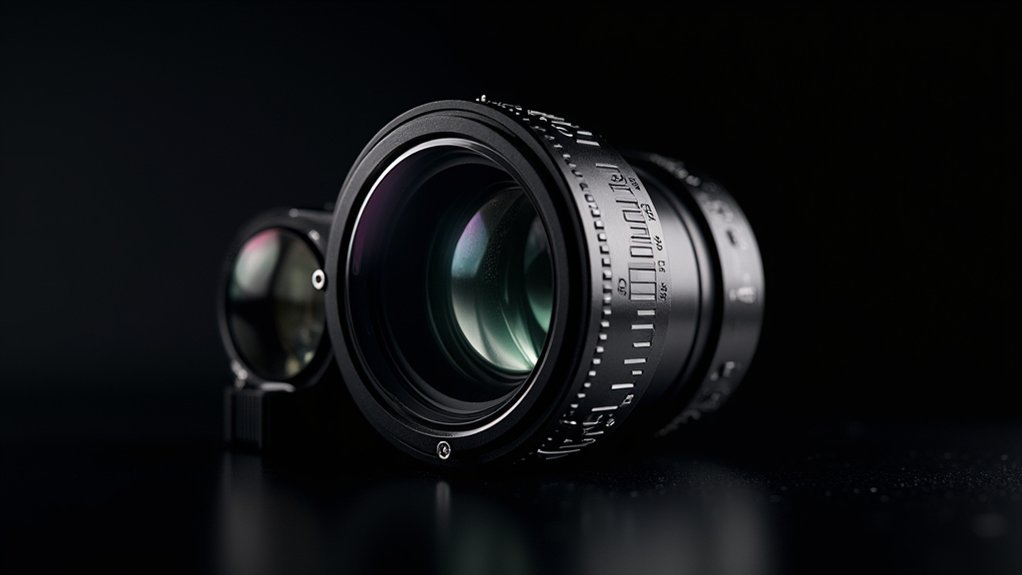Successful phase contrast imaging requires precise lens specifications. You’ll need objectives with appropriate numerical aperture (NA) values matched to your magnification needs—typically 0.25-1.4 NA. Verify your condenser’s annular diaphragm aligns perfectly with the objective’s phase ring. Working distance becomes critical for live cell applications, while optical correction systems minimize artifacts. Choose plan or apochromat objectives for superior field flatness and color correction. The following specifications will transform your microscopy results.
Second-Level Headings for “Complete Phase Contrast Lens Specifications for Imaging Success”

These headings address critical aspects of phase contrast objective lens performance, from technical parameters like numerical aperture (0.25-1.4) to practical considerations like proper alignment between the phase plate and condenser annulus.
Each section should detail how these specifications impact transparency visualization and overall imaging success in light microscopy applications.
Numerical Aperture and Magnification Requirements for Phase Contrast
In phase contrast microscopy, you’ll need to match your condenser’s annular diaphragm with your objective’s numerical aperture to prevent artifacts and light scattering.
When selecting from the typical 10x-100x magnification range, remember that higher magnifications require objectives with higher NAs and shorter working distances to maintain resolution.
The relationship between resolution and contrast is directly influenced by the NA value, where higher NAs (up to 1.4 in 60x apochromat objectives) provide superior detail resolution but may require careful adjustment to maintain ideal phase contrast.
Condenser-Objective NA Matching
Achieving ideal image quality in phase contrast microscopy depends critically on properly matching the numerical aperture (NA) of your condenser with that of your objective lens.
For best light collection and resolution, verify your condenser’s NA matches or exceeds your objective’s NA, which typically ranges from 0.25 to 1.4 for phase contrast work.
When using higher magnifications (up to 100x) for detailed cellular components, you’ll need objectives with higher NA values (approaching 1.4), which deliver superior resolution but reduce working distance.
Remember that proper alignment between the condenser’s annular diaphragm and the objective’s phase ring is essential for creating the desired phase shifts.
This precision in matching and alignment directly impacts your imaging success, especially when visualizing fine cellular details that require maximum contrast and resolution.
Magnification Range Selection
Selecting the right magnification range for phase contrast microscopy directly impacts your ability to visualize transparent specimens with ideal clarity. Typical magnifications span from 10x to 100x, with higher powers revealing detailed cellular structures and dynamics.
For effective imaging, you’ll need objectives with appropriate numerical aperture values—at least 0.25 for basic phase contrast, while a 100x objective with NA of 1.25 offers superior light gathering and resolution of subtle phase differences.
Remember that specimen thickness matters; higher magnifications may produce artifacts in thick samples due to out-of-focus regions.
Modern phase contrast objectives feature specialized optical corrections refined for specific magnification ranges, ensuring accurate visualization of transparent structures without distortion.
When selecting objectives, consider both the magnification power and corresponding NA to achieve excellent results.
Resolution-Contrast Relationship
The delicate balance between resolution and contrast forms the cornerstone of effective phase contrast microscopy, governed primarily by numerical aperture (NA) values.
When selecting phase contrast objectives, you’ll find higher NA lenses (like 1.4 NA with 60x magnification) greatly enhance your imaging capabilities by revealing subtle refractive index differences within transparent specimens.
Remember that resolution follows the formula: Resolution = 0.61 × λ / NA, highlighting why light-gathering ability matters so much.
Your magnification needs will vary—use 10x-20x for larger structures and 60x-100x for fine cellular details. However, magnification alone isn’t enough; you need objectives specifically designed for phase contrast with proper phase plates and annular apertures.
This combination allows you to visualize otherwise invisible cellular components with remarkable clarity.
Phase Plate Design and Light Transmission Characteristics
When examining the core elements of phase contrast microscopy, phase plates stand as essential components that fundamentally transform how we visualize transparent specimens. These precision-engineered elements introduce a λ/4 phase shift to light waves, creating interference patterns that reveal otherwise invisible structures.
You’ll find that phase plates are crafted from optically matched glass with carefully calculated thicknesses to achieve ideal phase manipulation. Their design must perfectly align with the condenser’s annular diaphragm to guarantee proper light transmission through your specimen.
High-quality coatings minimize reflections, preserving light intensity while maximizing contrast.
Understanding how variations in refractive index affect imaging is vital—different specimen components interact uniquely with light waves passing through the phase plate, directly impacting your visualization results.
This relationship between specimen properties and phase plate design determines your microscope’s ability to render transparent structures visible.
Working Distance Considerations for Live Cell Imaging

Working distance becomes critical when you’re conducting live cell imaging, as insufficient space between the objective and specimen can compromise cell viability through mechanical disturbance or heat transfer.
You’ll need to account for temperature gradient effects from high-NA objectives, which can create thermal stress on living samples if the working distance is too short.
Maintaining proper working distance helps prevent focus drift during extended time-lapse experiments, especially when using incubation chambers or environmental controls that may introduce subtle mechanical shifts.
Optimal Distance for Viability
Critical to successful live cell imaging, appropriate working distance between the objective lens and specimen directly impacts cell viability throughout observation periods.
When conducting phase contrast microscopy, you’ll need to balance magnification requirements with sufficient space for sample manipulation.
- Higher magnification objectives with high NA oil immersion typically offer minimal working distances (approximately 0.15 mm), limiting accessibility but providing superior resolution.
- LWD objectives (Long Working Distance) provide several millimeters of clearance between the front lens and cover glass—ideal for maintaining cell viability during extended observations.
- Modern objectives display working distance measurements directly on their barrels, helping you select the appropriate lens for your specific live cell application.
Remember that insufficient working distance risks damaging delicate specimens through unwanted contact with the objective.
Temperature Gradient Effects
Temperature gradients between the objective lens and your live cell specimens can greatly impact cellular behavior and imaging quality.
When using high numerical aperture objectives for phase contrast microscopy, you’ll face a trade-off between resolution and thermal stability. Objectives with shorter working distances (0.15 mm for 100x oil immersion) position heat sources closer to your samples, creating problematic temperature fluctuations.
For successful live cell imaging, select objectives with longer working distances (like 0.21 mm for 60x lenses) to accommodate temperature-controlled environments. This spacing helps maintain consistent refractive index while reducing thermal stress on specimens.
Remember that even small temperature variations can alter cellular processes, potentially compromising your experimental results. Always consider how your objective’s working distance will interact with your incubation system to preserve physiological conditions during extended imaging sessions.
Focus Drift Prevention
Beyond temperature control, maintaining stable focus during live cell imaging presents another significant challenge.
Working distance—the space between your objective lens and the cover glass—plays an essential role in phase contrast microscopy’s focus stability. When observing dynamic cellular processes, you’ll need to carefully select objectives that provide adequate clearance while maintaining clarity.
- High magnification objectives (like 100x oil immersion) typically offer minimal working distances (approximately 0.15mm), requiring precise specimen positioning to enhance phase difference visualization.
- Long working distance (LWD) objectives provide greater flexibility for live cell imaging, reducing the risk of accidental contact with your specimens.
- Proper working distance management enhances imaging quality by minimizing out-of-focus blur and preserving delicate live specimens.
You’ll achieve best results by selecting phase contrast objectives specifically designed for the working distance requirements of your particular live cell application.
Annular Diaphragm Matching and Alignment Precision

Proper matching and precise alignment of the annular diaphragm constitute the foundation of effective phase contrast microscopy.
You’ll need to verify that your annular diaphragm perfectly matches your phase contrast objective’s specifications, as each objective requires a specific diaphragm size corresponding to its numerical aperture (typically 0.25-1.4).
When the diaphragm isn’t precisely aligned with the phase plate, you’ll notice unwanted artifacts like halos or markedly reduced contrast in your images.
Regular calibration is essential to maintain ideal optical path length and prevent imaging quality deterioration.
Remember that the annular diaphragm controls which light angles illuminate your specimen, directly affecting the phase shifts that create contrast in transparent samples.
Make alignment checks part of your routine microscopy preparation to consistently produce high-quality phase contrast images.
Optical Correction Systems for Artifact Reduction
While precise alignment of annular diaphragms helps create basic contrast, your phase contrast images can still suffer from various optical artifacts. Specialized optical correction systems in phase contrast microscopy minimize these problems and enhance image clarity.
Apochromat objectives offer superior color correction across multiple wavelengths, reducing chromatic aberration when examining transparent specimens.
- Plan objectives maintain flat field correction, keeping your entire sample in focus across the field of view—critical for accurate cellular structure assessment.
- Anti-reflective coatings reduce flare and ghosting while increasing light transmission for improved contrast.
- Using appropriate immersion media (oil/water) with these corrected objectives increases numerical apertures, revealing finer details in specimens with varying refractive indices.
You’ll achieve dramatically clearer images by selecting objectives with the right combination of these correction features.
Frequently Asked Questions
How to Obtain a Good Image Under a Phase-Contrast Microscope?
To obtain a good image under a phase-contrast microscope, you’ll need to align the phase ring with the condenser annulus, use high NA objectives, prepare thin specimens, adjust light intensity properly, and keep optics clean.
What Is the Resolution Limit for Phase Contrast?
Your phase contrast microscope’s resolution limit is typically 0.5-1.0 micrometers, depending on your objective’s numerical aperture. You’ll get better resolution with higher NA values, like a 100x oil immersion objective.
What Can We Determine From This Phase Contrast Image of a Cell?
From this phase contrast image, you’ll observe cell morphology, nucleus, cytoplasm, organelles, and cellular boundaries. You can determine the cell’s structural integrity, identify dense components, and assess its functional state without staining.
How Does Phase Contrast Microscopy Improve Image Quality?
Phase contrast microscopy improves image quality by converting phase shifts into visible amplitude differences. You’ll see transparent cells clearly without staining, as it enhances contrast between structures with different refractive indices, revealing fine cellular details.
In Summary
When you’ve matched your phase contrast lenses perfectly to your research needs, you’ll achieve dramatically improved contrast and detail in transparent specimens. Remember to precisely align your annular diaphragm, select appropriate numerical aperture values, and consider working distance for your specific applications. Don’t overlook phase plate design—it’s essential for ideal light transmission. With these specifications optimized, you’ll eliminate artifacts and capture the cellular dynamics you’re seeking.





Leave a Reply